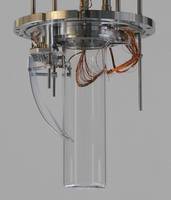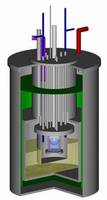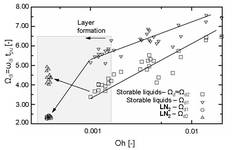experiments with cryogenic liquids
introduction
Apart from being interesting for the exploration of the vicinity of the inviscid flow limit due to their very low viscosities, cryogenic liquids can deliver key knowledge about the behavior of the cryogenic propellants in the tanks of the future space vehicles at the transition to and during the ballistic (microgravity) phases.
The scientific goal of the presented experiments is the investigation of dynamical behavior of the interface between a cryogenic liquid and its vapor upon step reduction of gravity under isothermal conditions in axisymmetric container geometries. Thus the dynamical wetting process in this single species 2-phase system is not influenced by any thermal effects (heat flux from the container wall, phase transition at the interface, etc.). During the experiments the liquid interface is driven out of its initial equilibrium and essentially flat shape upon step transition to microgravity because the capillary forces become dominant over the gravity forces. The interface undergoes thereafter a series of damped oscillations with vanishing amplitudes which settle down eventually and the end equilibrium round shape is established.
The interface dynamics are described by;
- characteristic for the isothermal flow dimensionless numbers (such as the Morton Mo and the Ohnesorge Oh numbers) and the static contact angle,
- the frequency and damping behaviour of the already mentioned interface oscillations,
- the lack or the formation/break-up of a macroscopical liquid layer on the wall and
- the equilibrium interface shapes.
The evaluation of characteristics 2) to 4) of the drop tower experiments is the objective of the experimental detection. Both contact angles, the static and the dynamic, are assumed to be 0° for the cryogenic liquids in contact with glass.
experimental setup
The main objective by the development of the experimental setup is ensuring the isothermal cryogenic conditions in the test cell (Fig.1): container walls and cryogenic liquid/vapor at the same temperature. Therefore a bath cryostat (Fig.2) is used, in which the test cell is placed, cooled by a cryogenic bath of liquid nitrogen and double isolated from the environment by an inner and outer vacuum. Thus minimizing the heat flow into the test cell prevents strong evaporation and nucleate boiling on the container walls of the test cryogenic liquid, given its very small evaporation enthalpy by ambient pressure.


The container of the test cryogenic liquid is a right circular test cylinder with an inner diameter of 51 mm and is made of glass (fused silica). A temperature sensor in the liquid and the vapor phase are installed. The pressure in the test cell is detected by a pressure sensor via pressure transducer through the top flange of the cryostat and can be additionally manipulated by a pressure tank outside of the cryostat. These measures for pressure and temperature management & control allow the achievement of predefined thermodynamical conditions of the experiments, and so a parameter variation, e.g of Ohnesorge Oh number.
A high speed CCD camera, recording up to 125 frames per second, observes the interface via endoscope through the top flange of the cryostat.
experimental results
Drop tower microgravity experiments under isothermal conditions and varying the system pressure (and thus the Oh number) with liquid nitrogen (LN2) are successfully carried and evaluated. In general the frequency and damping behavior is found to be different from those of storable liquids so that these characteristic can not be extrapolated from the storable liquids data (Fig. 3). A reversed ratio of the dimensionless frequencies of the first 2 oscillations of the axial center point of the interface is observed for LN2 compared to the storable liquids.
numerical simulations
Numerical simulations accompany the experiments through the commercial CFD code FLOW3D and through the open source CFD code OpenFOAM using the the one fluid VOF scheme and assuming laminar Newtonian flow. Both codes reproduce the isothermal experiments qualitatively good with OpenFOAM results in better quantitative agreement.
To view the predicted behavior of liquid Nitrogen (LN2) download the animation of an CFD-calculation by FLOW3D or OpenFOAM.
The funding of the drop tower flights and the funding of the research project by the German Federal Ministry of Education and Research (BMBF) through the German Aerospace Center (DLR) under grant numbers 50WM0241 (discontinued) and 50 RL 0921 are gratefully acknowledged.
Partial funding and support for building the experiment setup has been provided by EADS-ST Bremen and is gratefully acknowledged.
publications
M. Stief, M. E. Dreyer, H. J. Rath: "Reorientation of Cryogenic Fluids Upon Step Reduction of Gravity", Drop Dower Days 2004, Bremen, Germany
M. Stief, J. Gerstmann, M.E. Dreyer: “Reorientation of Cryogenic Fluids Upon Step Reduction of Gravity”, PAMM · Proc. Appl. Math. Mech. 5, 553–554 (2005)
The funding of the drop tower flights and the funding of the research project by the German Federal Ministry of Education and Research (BMBF) through the German Aerospace Center (DLR) under grant numbers 50WM0241 (discontinued) and 50 RL 0921 are gratefully acknowledged.



 "
"